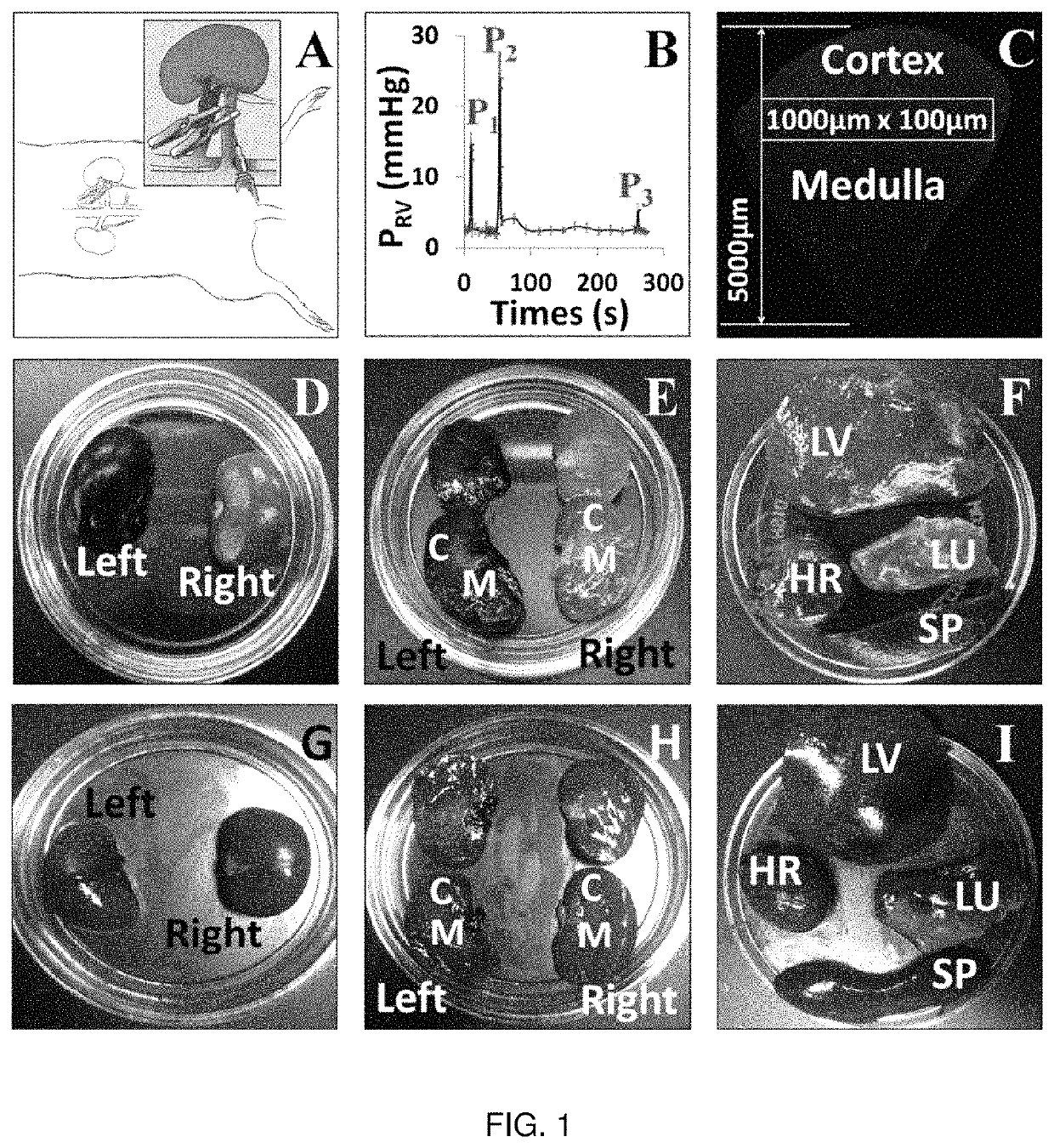Hydrodynamic method and apparatus for delivering fluids to kidney tissues
a technology of kidney tissue and fluid delivery, applied in the direction of peptide/protein ingredients, angiography, catheters, etc., can solve the problems of inability to achieve widespread use of any of these methods, difficult to achieve efficient gene transfer routinely, intrinsic challenges to gene transfer processes, etc., to prevent kidney pathology and prevent kidney pathology
- Summary
- Abstract
- Description
- Claims
- Application Information
AI Technical Summary
Benefits of technology
Problems solved by technology
Method used
Image
Examples
example 21
Hydrodynamic Methods for Transgene Expression in Kidney Tissues
[0194]A. Materials and Methods
[0195]Cell Culture
[0196]Mouse Kidney Cell Culture. The inventors used epithelial cells from the S3 segment of the proximal tubules. These cells were cultured in medium prepared by combining 500 ml of essential medium (Fisher Scientific, Pittsburgh, Pa.) with 7.5% of sodium bicarbonate, 7% of fetal bovine serum (FBS), and 1% of Pen-Strep, (Fisher Scientific, Pittsburgh, Pa.). The cells were grown in a 37° C., 5% CO2, 38% O2 humid incubator.
[0197]MDCK Cell Culture. Madin-Darby Canine Kidney (MDCK) strain II cells, were grown in minimal essential media (Fisher Scientific, Pittsburgh, Pa.) with 8% fetal bovine serum, 1% L-glutamine, penicillin / streptomycin (Fisher Scientific, Pittsburgh, Pa.) and hygromycin (Calbiochem, San Diego, Calif.), and kept in a 37° C., 5% CO2 humid incubator.
[0198]Rats
[0199]Male and female Sprague Dawley (Harlan Laboratories, Indianapolis, Ind.) and Munich Wistar rats (...
example 22
Acute Kidney Injury Therapy
[0257]All renal injuries were generated using micro-serrefines. Rats were anesthetized from intraperitoneal injections of 50 mg / kg pentobarbital, and then placed on a heating pad to maintain normal physiological body temperature. Once fully sedated, their abdomen was shaved, cleaned with betadine solution and midline incisions were created to isolate the renal pedicles. Thereafter, bilateral renal pedicle clamps were used to occlude blood flow for two specific periods: 10-15 and 30-45 minutes. These damp times correspond to mild, acute kidney injuries respectively. After each period of ischemia, the micro-serrefines were removed to reinstate renal blood flow and the animals were prepared to receive hydrodynamic transgene delivery 60 minutes and 24 hours (timeframe for maximal injury with AKI) after ischemia / reperfusion injury. In the case of the 24-hour injection time point, each rat was allowed to recover from the effects of the anesthetic. After isolatin...
example 23
Ischemia Therapy
[0260]Ischemia-reperfusion injuries remain a significant clinical problem, as approximately 25% of ICU patients experience acute kidney injury (AKI). These patients have increased risk of end-stage renal failure, and mortality. Therapy of AKI depends on the identification and treatment of its underlying cause(s), yet current treatment regimens are mainly supportive. In the absence of hypervolemia, intravenous fluid delivery is oftentimes the first course of treatment. This standard approach is employed to prevent or eliminate volume depletion, ameliorate tubular blockage, dilute nephrotoxin, facilitate diuresis and restore normal GFR. In this study, the inventors investigated the therapeutic potential of a relatively low volume (0.5 ml) hydrodynamic isotonic fluid delivery to the left renal vein 1 and 24 hours after inducing moderate ischemia-reperfusion injury. Strikingly, from only the fluid delivered at the 24-hour mark, the inventors observed substantial and stat...
PUM
| Property | Measurement | Unit |
|---|---|---|
| pressure | aaaaa | aaaaa |
| volume | aaaaa | aaaaa |
| length of time | aaaaa | aaaaa |
Abstract
Description
Claims
Application Information
 Login to View More
Login to View More - R&D
- Intellectual Property
- Life Sciences
- Materials
- Tech Scout
- Unparalleled Data Quality
- Higher Quality Content
- 60% Fewer Hallucinations
Browse by: Latest US Patents, China's latest patents, Technical Efficacy Thesaurus, Application Domain, Technology Topic, Popular Technical Reports.
© 2025 PatSnap. All rights reserved.Legal|Privacy policy|Modern Slavery Act Transparency Statement|Sitemap|About US| Contact US: help@patsnap.com



